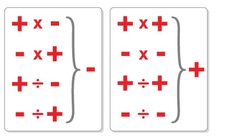

You can also use negative numbers for more abstract ideas. For instance, the temperature on this thermometer is -20, or twenty degrees below zero. For example, have you ever been outside on a really cold winter day when the temperature was below zero? Any temperature below zero is a negative number. However, there are instances in real life where you use numbers that are less than zero. It's difficult to imagine having less than nothing in this case. For instance, if you have 0 pieces of chocolate left in your candy bowl, you have no candy.

After all, we often think of zero as meaning nothing. It might seem a little odd to say that a number is less than 0. For instance, -7 is a number that is seven less than 0. −1 bears relation to Euler's identity since e iπ = −1./en/algebra-topics/exponents/content/ What are negative numbers?Ī negative number is any number that is less than zero.
NEGATIVE MINUS NEGATIVE NUMBER SOFTWARE
In software development, −1 is a common initial value for integers and is also used to show that a variable contains no useful information. When a subset of the codomain is specified inside the function, it instead denotes the preimage of that subset under the function. For example, sin −1( x) is a notation for the arcsine function, and in general f −1( x) denotes the inverse function of f( x). This definition is then extended to negative integers, preserving the exponential law x a x b = x ( a + b) for real numbers a and b.Įxponentiation to negative integers can be extended to invertible elements of a ring, by defining x −1 as the multiplicative inverse of x.Ī −1 that appears as a superscript of a function does not mean taking the (pointwise) reciprocal of that function, but rather the inverse function of the function. We make the definition that x −1 = 1 / x, meaning that we define raising a number to the power −1 to have the same effect as taking its reciprocal. In the algebra of quaternions – where the fundamental theorem does not apply – which contains the complex numbers, the equation x 2 = −1 has infinitely many solutions.Įxponentiation to negative integers Įxponentiation of a non‐zero real number can be extended to negative integers. The only other complex number whose square is −1 is − i because there are exactly two square roots of any non‐zero complex number, which follows from the fundamental theorem of algebra. The above arguments hold in any ring, a concept of abstract algebra generalizing integers and real numbers.Īlthough there are no real square roots of −1, the complex number i satisfies i 2 = −1, and as such can be considered as a square root of −1. 
But now adding 1 to both sides of this last equation implies The third equality follows from the fact that 1 is a multiplicative identity. The first equality follows from the above result, and the second follows from the definition of −1 as additive inverse of 1: it is precisely that number which when added to 1 gives 0. As a consequence, a product of two negative numbers is positive.įor an algebraic proof of this result, start with the equation So (−1) ⋅ x is the additive inverse of x, i.e. 0, 1, −1, i, and − i in the complex or cartesian plane







 0 kommentar(er)
0 kommentar(er)
